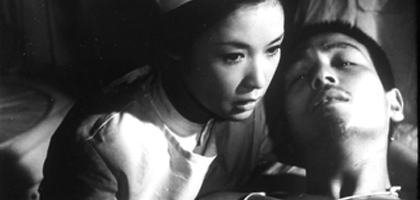Primary navigation


Tim Lucas on a potent and bloodsoaked tale of saints and sinners set at the height of the Sino-Japanese war
This unrelentingly grim melodrama continues Fantoma's rewarding series of films by Japanese director Masumura Yasuzo, following the release of Giants & Toys (Kyojinto gangu, 1958), Afraid to Die (Karakkaze yarô, 1960), Manji (1964) and the fetishistic Edogawa Rampo horror film Blind Beast (Môjuu, 1969).
Set in 1939 at the height of the Sino-Japanese war, Red Angel (Akai tenshi) stars the luminous Wakao Ayako (a frequent star of Masumura's work) as military nurse Nishi Sakura who, after being stationed at the Tientsin military hospital, is almost immediately raped by a recovering private (Kawazu Yusuke) while the other wounded men in her ward hold her down. After reporting the incident to her prim, look-the-other-way superior (Ikegami Ayako), Sakura and her attacker are both reassigned to the front. She later finds her rapist dying in her ward, at once cursing her for his reassignment to this hell-on-earth and apologising for his past transgressions, while begging for her to save his miserable life. Guilt-ridden, Sakura pleads with the doctor in charge (Ashida Shinsuke) to give him a blood transfusion, though such a life-saving measure is a privilege reserved only for officers. The doctor agrees - on condition she visit his room later, which she accepts. The door is thus opened on a difficult and moving relationship between the doctor (an elderly-seeming man of only 40 who is addicted to morphine) and Sakura, whom he needs only to administer his shots and cuddle him, since the narcotic has rendered him impotent. 'The only way to get through this war is to consider everyone a stranger,' he cautions her, to which she staunchly replies, 'I refuse.' While the film is largely about this unpromising yet oddly absorbing relationship, its most poignant scenes chronicle Sakura's almost saintly attention to the pathetic private - now an armless amputee whom the Japanese army considers a poor advertisement for the war and so refuses to send home - which becomes sexual as he pleads with her to relieve him in a way he cannot and to make her body available to him.
Much as Blind Beast seems shocking to western sensibilities for the dark extremes of erotic fetishism it portrayed onscreen in 1969, this somewhat earlier film contains correspondingly intensive scenes in which bloodsoaked operating theatres are indistinguishable from abattoirs, the gruelling dramatisations of amputations somehow made more horrible by Kobayashi Setsuo's elegant black-and-white Daieiscope cinematography, beautifully preserved in Fantoma's spotless 2.35:1 anamorphic transfer. Masumura takes a less graphic approach to the film's eroticism, but it is all the more pointed and powerful for its restraint. A scene of Sakura dropping her towel and presenting her naked body to the astonished amputee is particularly effective in that it shows nothing but the silhouette of her torso, investing it with immense magic and mystery. The horrific battle scenes, yielding 'mountains' of identification tags, have an impressive sense of scale, comparable in places to the acres of wounded revealed by the crane shot of the Alabama railway station in Gone with the Wind, but here you can almost smell the stench of death. The lovely score by Ikeno Sei, who also provided the music for Toho's 'Zaitoichi' films, adds immeasurably to the picture's warmth and intimacy, underlining its message that very potent human bonds can sometimes be forged in the least humane of places.
Optional English subtitles accompany the well-recorded Japanese soundtrack. These appear to be attentive to the subtle inflections of the dialogue, rendered convincing by the uniformly impressive performances. The extras include a slightly worn anamorphic trailer, a so-so image gallery and a Masumura biography and filmography by the erudite Earl Jackson Jr, who also contributed an essay to the menu enclosure.